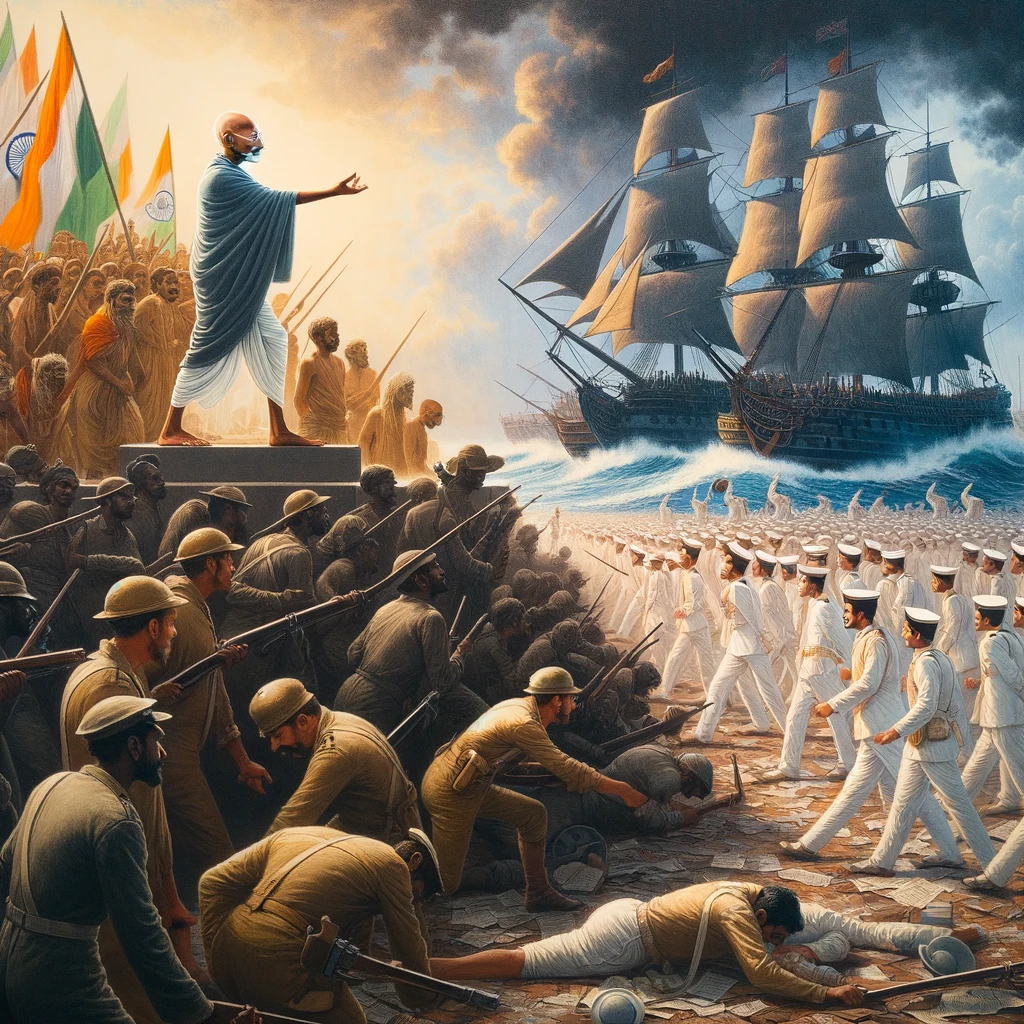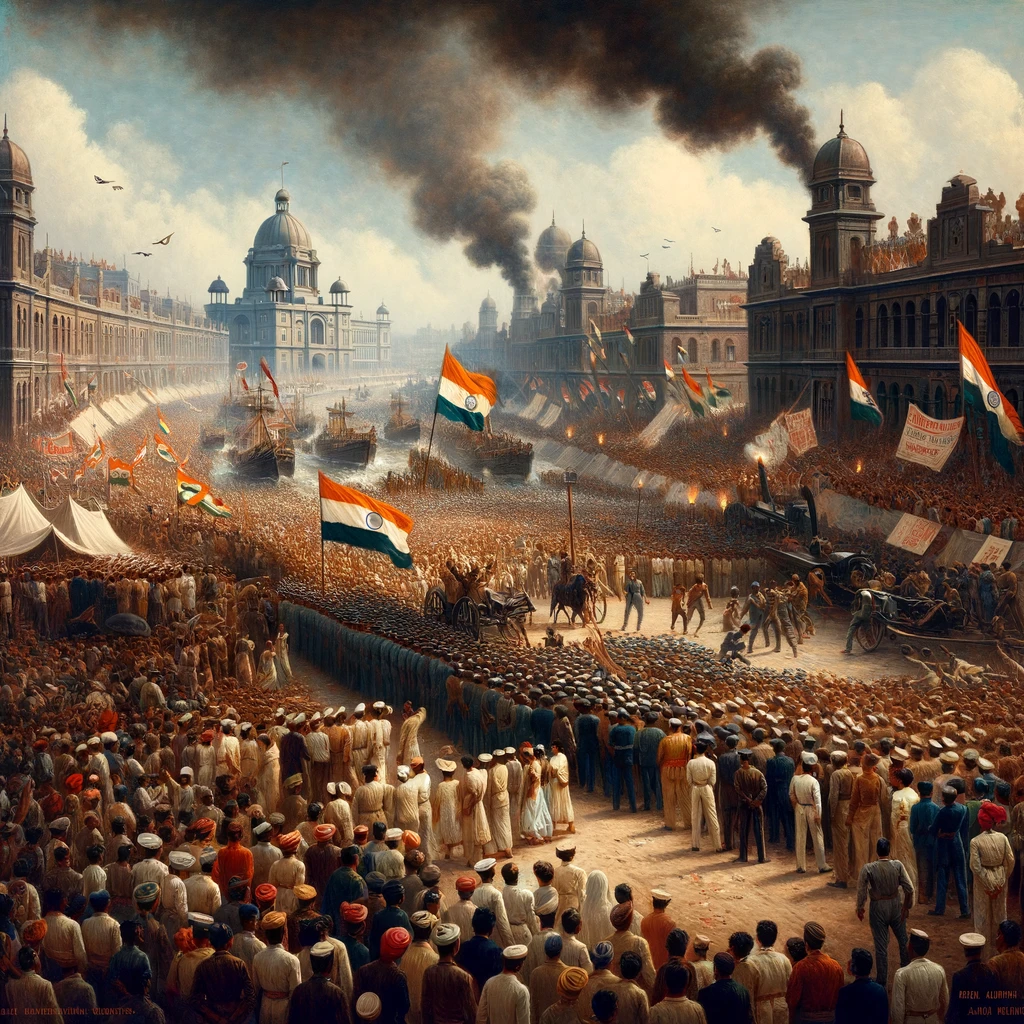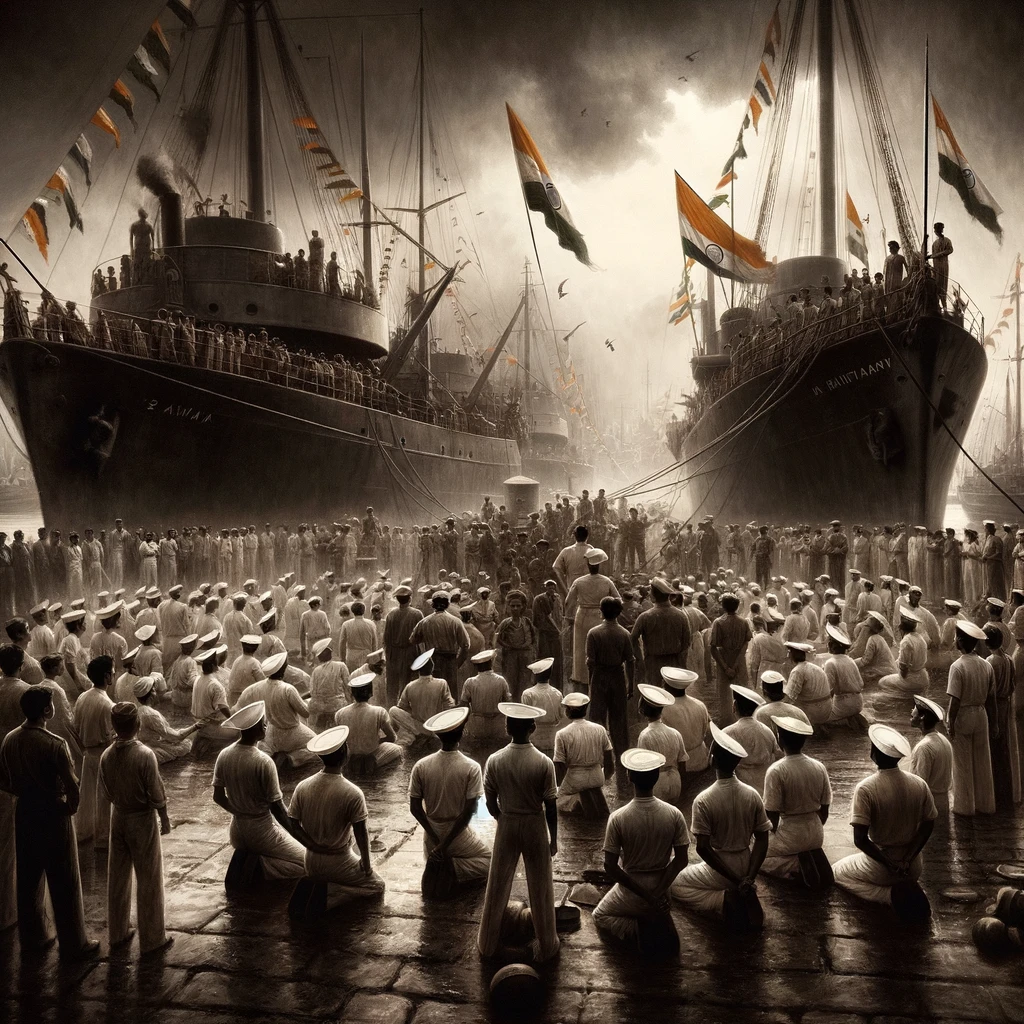Royal Indian Navy Uprising
The Royal Indian Navy Uprising has often been overshadowed in the grand tapestry of India’s struggle for independence. Lost in the crumbling pages of history, the event has not been accorded its due prominence, largely because the predominant narratives, sculpted by authors aligned with the Indian National Congress, have tended to magnify the role of Mahatma Gandhi to the exclusion of other significant movements. This essay seeks to analyze the multifaceted nature of the uprising, recognizing its critical role and the broader spectrum of forces that culminated in India’s eventual liberation from British colonial rule. By delving into the untold stories of the sailors’ revolt, we aim to shed light on the complexities and the collective efforts that contributed to the country’s path to independence.
Introduction
The Royal Indian Navy Uprising occupies a critical but underrepresented chapter in the narrative of India’s emancipation. In the pivotal month of February 1946, the sailors of the Royal Indian Navy boldly rose against the yoke of British dominion, signaling a profound shift in the tide of nationalist sentiments that pervaded the subcontinent. The rebellion was more than a plea for improved conditions and recognition; it was an articulation of the collective urgency for autonomy that was simmering within the nation.
At a moment when the efficacy of non-violent protest was being questioned, the uprising highlighted the pressing need for a more forthright stance against colonialism. While Gandhi’s philosophy of Satyagraha had been instrumental in India’s fight, the uprising laid bare the inadequacies of passive resistance in compelling the British towards substantial change. The revolt of the Royal Indian Navy thus emerged as a defining episode, encapsulating the waning patience of the Indian populace and their disenchantment with the protracted struggle for sovereignty. It was a clarion call for immediate action, steering the independence movement onto a path that embraced a diversity of strategies in pursuit of freedom.
Background to the Royal Indian Navy Uprising
The journey to the Royal Indian Navy Uprising winds through decades of relentless struggle for independence from British rule. India’s fight for freedom featured a mosaic of movements and ideologies, with Gandhi’s Satyagraha emerging as a beacon of non-violent resistance. Satyagraha, advocating for truth and firmness in the face of injustice, became the bedrock of numerous campaigns against colonial policies. Key events like the Salt March of 1930 and the Quit India Movement of 1942 mobilized millions, showcasing the power of peaceful protest.
However, as the movement progressed, the effectiveness of Satyagraha in compelling British authorities to make substantial concessions came under scrutiny. Despite its widespread support and moral high ground, Satyagraha often resulted in mass detentions and severe crackdowns, with little to show in terms of immediate political gains. The frustration with this lack of progress set the stage for the Royal Indian Navy Uprising.
This turning point reflected a broader sentiment that peaceful resistance alone might not suffice to end British dominion. Sailors and soldiers, many of whom had served in World War II, returned home only to face discrimination and disenchantment. The ideals of Satyagraha, while noble, seemed distant to their immediate sufferings and aspirations for equality and respect. Consequently, the seeds of discontent grew, eventually culminating in the Royal Indian Navy Uprising. This uprising did not just challenge British authority; it questioned the prevailing strategies of the independence movement, signaling a critical shift towards more direct forms of confrontation.
Gandhi’s Non-violent Resistance and the Prelude to the Royal Indian Navy Uprising

Gandhi’s non-violent resistance, while pioneering a unique approach to liberation struggles, faced critical challenges in compelling the British to end their colonial rule in India. This section delves into the reasons why many perceived Satyagraha as inadequate in addressing British atrocities and accelerating the path to independence, setting a crucial backdrop for the Royal Indian Navy Uprising.
Challenges to Satyagraha
Firstly, the British response to non-violent protests often involved repression, including mass arrests, violence, and economic sanctions, which inflicted significant suffering on the Indian populace. Despite the moral high ground Satyagraha aimed to maintain, these brutal crackdowns showcased the British administration’s resolve to cling to power, dampening hopes for a swift and peaceful transition to independence.
Moreover, the pace of political change under Gandhi’s strategy appeared slow to those bearing the immediate brunt of colonial exploitation and discrimination. The long intervals between major campaigns of civil disobedience allowed the colonial regime to regroup and reinforce its dominance, further delaying meaningful negotiations for self-rule.
Support of World War II without Promise
Critically, the outbreak of World War II and the Indian National Congress’s initial decision to withhold support from the British war effort without promises of post-war independence marked a pivotal moment. Gandhi’s subsequent launch of the Quit India Movement in 1942, although a bold call for immediate British withdrawal, resulted in widespread arrests, leaving a leadership vacuum and a demoralized base of support. This period underscored the limitations of non-violent resistance in achieving immediate political objectives against a colonial power unwilling to concede.
The cumulative effect of these factors contributed to a growing sentiment among Indians, particularly among the younger generation and the military personnel who had witnessed the horrors of war and longed for decisive action. They yearned for a strategy that could more directly confront British rule and catalyze the end of colonial oppression.
In this context, the Royal Indian Navy Uprising emerged not merely as an isolated act of defiance but as a critical juncture in the independence movement. It reflected the broader disillusionment with the pace of change under non-violent resistance and the increasing readiness among Indians to adopt more confrontational means in their quest for freedom. The uprising thus signaled a significant shift in the dynamics of India’s struggle for independence, embodying the urgent desire for immediate and tangible results.
The Catalyst of Change: The Royal Indian Navy Uprising

The Royal Indian Navy Uprising, a landmark event in India’s struggle for independence, began on February 18, 1946, with its epicenter in Bombay. This section outlines the buildup, key participants, and the unfolding of the uprising, shedding light on its significance and impact.
The Spark of Rebellion
The seeds of the uprising took root in the grievances of naval ratings over racial discrimination, poor living conditions, and the lack of recognition for their service during World War II. The immediate spark came when ratings from HMIS Talwar protested against the poor quality of food and discriminatory treatment by British officers. This act of defiance quickly spread across the naval establishments in Bombay and then to other parts of India, including Karachi, Calcutta, and Madras, involving over 20,000 sailors.
Key figures in this uprising were not just the sailors but also the political leaders and activists who supported their cause, albeit cautiously. The ratings, displaying unprecedented unity and organization, took control of ships and shore establishments, hoisted flags symbolizing Indian independence, and broadcasted their demands, which included the release of political prisoners and the withdrawal of Indian troops from Indonesia.
A Nationwide Movement
The sequence of events during the Royal Indian Navy Uprising showcased a remarkable level of coordination among the rebels, who managed to paralyze the naval operations and even garnered significant civilian support. Mass protests and strikes erupted in Bombay and other cities, expressing solidarity with the naval ratings and further challenging British authority.
However, the British response was swift and severe, with reinforcements called in to suppress the uprising. Despite the initial reluctance of Indian political leaders to support the revolt, fearing it might derail the negotiations for independence, the eventual crackdown led to widespread condemnation of the British actions and a realization of the urgent need for a political solution to India’s demand for freedom.
Lasting Impact
The Royal Indian Navy Uprising, though brief, had a profound impact on the Indian independence movement. It demonstrated the increasing untenability of British rule and highlighted the role of Indian armed forces personnel in the nationalistic struggle. The uprising not only intensified the pressure on the British to leave India but also marked a significant shift in the tactics of the independence movement, illustrating the growing impatience and radicalization among its younger participants.
Unveiling the Motivations Behind the Royal Indian Navy Uprising
The Royal Indian Navy Uprising did not erupt in a vacuum. It stemmed from deep-seated frustrations among the sailors regarding racial discrimination, substandard living conditions, and the powerful influence of nationalist sentiments sweeping across India. These sailors, having served alongside Allied forces during World War II, returned with heightened expectations of respect and equity. Instead, they encountered stark disparities in treatment and opportunities compared to their British counterparts, igniting a sense of injustice and betrayal.
Nationalist fervor further fueled the uprising. The Quit India Movement and other acts of defiance against British rule had sown seeds of resistance among the ranks. Exposure to the global upheaval and the fight against fascism inspired a vision of an independent India, free from colonial oppression. The sailors’ actions thus resonated with a broader struggle for freedom, transcending individual grievances to embody a collective demand for national liberation.
Immediate Responses to the Royal Indian Navy Uprising
The British authorities, caught off guard by the scale and intensity of the uprising, responded with a mix of military force and negotiations. They deployed troops to quell the disturbances, leading to clashes and the imposition of martial law in some areas. The British realized the gravity of the situation, recognizing that the revolt not only threatened their immediate control but also the very future of colonial rule in India.
Indian leaders, including those from the Indian National Congress and the All India Muslim League, faced a dilemma. Initially hesitant to endorse the uprising outright, fearing it might jeopardize the delicate negotiations with the British, they nevertheless expressed sympathy for the sailors’ demands. Mahatma Gandhi and other leaders condemned the use of violence but acknowledged the justness of the sailors’ grievances, advocating for a peaceful resolution.
The general population’s response ranged from enthusiastic support to cautious optimism. Mass demonstrations and strikes erupted in various cities, showing solidarity with the naval ratings. This public outcry reflected a widespread disillusionment with British authority and a fervent desire for independence. The uprising thus galvanized the Indian public, bridging divides between military and civilian spheres of resistance against colonial rule.
The Royal Indian Navy Uprising, through its motivations and the reactions it elicited, highlighted the complex dynamics of India’s struggle for independence. It underscored the sailors’ aspirations for dignity and equality, challenged the British colonial machinery, and demonstrated the Indian leadership’s and public’s readiness to support more assertive actions towards achieving freedom.
Role of Gandhi’s Satyagraha in Context of Royal Indian Navy Uprising
Gandhi’s Satyagraha, a philosophy and practice of non-violent resistance, profoundly influenced India’s struggle for independence. Yet, the emergence of the Royal Indian Navy Uprising prompts a critical examination of its impact and the dynamics between peaceful protest and direct action. This section delves into the intricate relationship between Gandhi’s non-violent strategies and the motivations behind the uprising, alongside the public’s reaction to it.
Satyagraha’s Influence and Limitations
Gandhi’s Satyagraha aimed to achieve political objectives through moral superiority and non-violence, inspiring widespread national and international support for India’s independence movement. His teachings and actions laid a foundational ethos of resistance against injustice within the Indian psyche. However, the slow pace of political concessions from the British, despite significant sacrifices by Indian protesters, led to growing impatience and disillusionment among many, especially the younger generation and those in the armed forces like the naval ratings involved in the Royal Indian Navy Uprising.
The Naval Ratings’ Revolt
The naval ratings’ decision to revolt, though seemingly at odds with Gandhi’s principles, actually reflected the broader spectrum of resistance within the independence movement. The sailors were part of a society deeply influenced by Gandhi’s calls for self-respect and freedom, and their actions demonstrated an acute awareness of their rights and a determination to challenge their continued denial. In this light, the uprising can be seen as an expression of the desire for immediate change, spurred by the broader ethos of resistance that Gandhi himself had championed, albeit through different means.
Public Response and the Quest for Independence

The public’s support for the Royal Indian Navy Uprising further illustrates the complex relationship between Gandhi’s non-violent resistance and other forms of protest. While Gandhi and other leaders initially expressed reservations about the uprising due to its violent elements, the widespread public empathy for the sailors’ plight and their demands indicates a nuanced understanding of the struggle for independence. The Indian populace, having been schooled in the principles of Satyagraha, recognized the moral righteousness of the sailors’ cause, even if their methods diverged from Gandhi’s teachings.
The argument that the failure of non-violent methods contributed to the outbreak of the Royal Indian Navy Uprising gains credence when considering the broader context of the independence movement. The slow pace of change and the harsh repression of peaceful protests by the British often led to a sense of frustration and desperation. This environment made more direct forms of confrontation, such as the uprising, seem like necessary steps towards achieving the ultimate goal of independence.
Conclusion: A Critical Juncture in the Movement
In conclusion, the Royal Indian Navy Uprising represented a critical juncture in the independence movement, reflecting both the influence and limitations of Gandhi’s Satyagraha. While Gandhi’s philosophy of non-violent resistance laid the moral and ethical groundwork for the independence struggle, the uprising underscored the diversity of tactics within the movement and the complex interplay between patience and urgency in the quest for freedom.
Impact and Aftermath of the Royal Indian Navy Uprising
The Royal Indian Navy Uprising, though brief in duration, left an indelible mark on the course of India’s independence movement and the eventual dismantling of British colonial rule. This section assesses the uprising’s immediate and enduring impacts, its influence on the British decision to leave India, and its legacy within the broader narrative of India’s quest for freedom.
Immediate Consequences and National Response
The immediate aftermath of the Royal Indian Navy Uprising saw a swift crackdown by the British authorities, aiming to quickly quell the rebellion and restore order. However, the uprising had already ignited a nationalistic fervor among the Indian populace and significantly eroded the legitimacy of British rule. The boldness of the naval ratings and the widespread public support for their cause demonstrated the depth of the desire for independence, signaling to both the British and Indian leaders that the status quo was untenable.
Long-Term Effects on British Colonial Exit
In the long term, the Royal Indian Navy Uprising accelerated the British government’s reassessment of its ability to maintain control over its Indian colony. Coming on the heels of World War II, the British were already weakened and facing intense pressure to decolonize. While the uprising was not the sole factor leading to the British decision to leave India, it significantly contributed to the growing realization that Indian independence was imminent. The event underscored the volatility of colonial rule and the potential for widespread rebellion, pushing the British to expedite negotiations with Indian leaders.
Influence on the Indian Independence Movement
Moreover, the uprising had profound implications for the Indian independence movement itself. It showcased the potential for armed forces personnel to join the struggle, breaking the stereotype that the military would remain loyal to the British. This realization galvanized the movement, providing a new impetus for unity and action among various factions of the Indian political spectrum.
The Uprising’s Legacy
The legacy of the Royal Indian Navy Uprising in the context of India’s struggle for independence is multifaceted. It represents a moment when the simmering discontent among Indians found a powerful expression, transcending the boundaries between civilian and military spheres of resistance. The uprising is a testament to the courage and determination of those who dared to defy the might of the British Empire, contributing to the cumulative pressure that eventually led to India’s independence in August 1947.
Reflecting on the Royal Indian Navy Uprising, it becomes clear that this event was more than just a mutiny; it was a pivotal moment that highlighted the cracks in British colonial power and the unyielding spirit of the Indian people. Its impact resonated far beyond the immediate political consequences, contributing to the collective memory of the nation’s struggle for freedom and serving as a symbol of the bravery and sacrifice of those who fought for India’s independence.
The Royal Indian Navy Uprising and India’s Path to Independence
The Royal Indian Navy Uprising serves as a defining chapter in the saga of India’s struggle for freedom from British colonial rule. This essay has traversed the backdrop of Gandhi’s non-violent Satyagraha, the deep-seated frustrations leading to the uprising, and the pivotal role it played in signaling the end of British dominance in India. The uprising, marked by the sailors’ courageous defiance, underscored the limitations of peaceful protest in achieving immediate political change and highlighted a growing demand for more direct forms of action.
The Interplay of Resistance Strategies
The complex interplay between non-violent resistance and direct action emerges as a central theme in understanding the dynamics of independence movements. The Royal Indian Navy Uprising exemplifies how movements evolve, often incorporating diverse strategies in response to changing circumstances and escalating pressures. Gandhi’s philosophy of Satyagraha laid the ethical groundwork for India’s independence struggle, instilling a sense of moral purpose and unity among Indians. However, the uprising illustrated the limits of patience among those who bore the brunt of colonial oppression and sought more immediate resolutions to their plight.
Historical Significance and Legacy

Reflecting on the historical significance of the Royal Indian Navy Uprising, it is clear that this event did more than challenge British authority; it catalyzed a shift in the national consciousness, fostering a renewed sense of urgency and possibility among Indians from all walks of life. The uprising not only contributed to the hastening of British departure but also enriched the narrative of India’s path to independence, showcasing the multifaceted nature of resistance against colonial rule.
In conclusion, the Royal Indian Navy Uprising remains a testament to the courage and resolve of the Indian people in their quest for freedom. It highlights the evolution of independence movements, which often encompass a spectrum of strategies, from non-violent resistance to direct action. The uprising’s legacy continues to inspire future generations, serving as a powerful reminder of the sacrifices made and the indomitable spirit that eventually led to India’s independence. This pivotal moment in history underscores the complexity and depth of the struggle for freedom, marking the Royal Indian Navy Uprising as a crucial milestone in the annals of India’s journey towards sovereignty and self-determination.
Feature Image: This sepia-toned image conveys a powerful moment of congregation and potential confrontation. Indian sailors in white uniforms are gathered en masse on Bombay dock, facing two large naval ships. Some sailors are kneeling in the forefront, while others stand in ranks or look towards the officers and the ships. Flags flutter in the air, including what appears to be the flag of India, symbolizing a mix of military discipline and nascent nationalism. The scene is charged with a solemn gravity, suggesting a moment before a significant event, possibly a mutiny or protest. (https://hinduinfopedia.in/wp-content/uploads/2024/02/DALL·E-2024-02-19-08.28.02_Royal_Indian_Navy_Uprising.webp)
